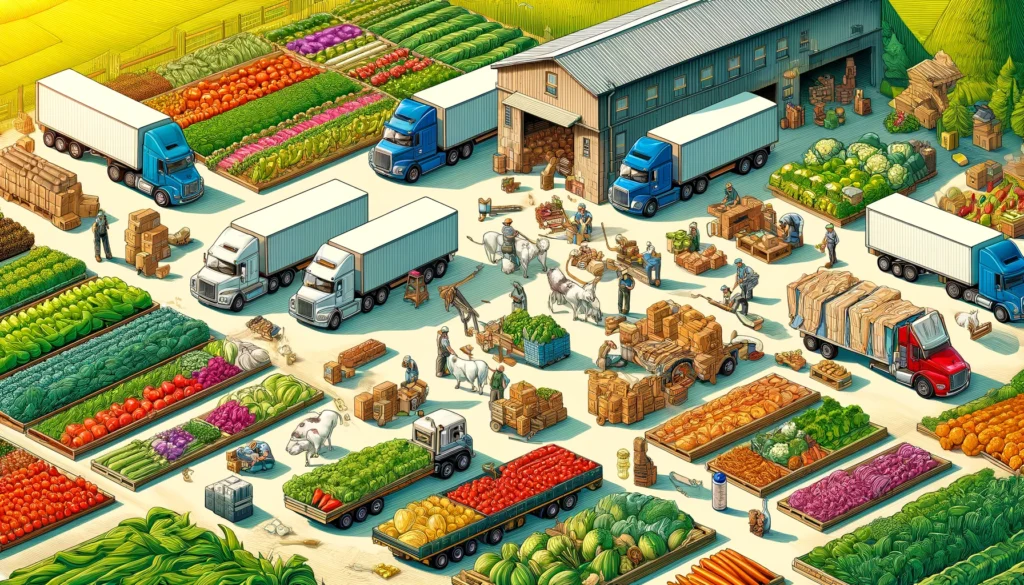
Food Distribution A detailed and vibrant illustration depicting food distribution on a farm. The scene shows farmers and workers loading agricultural products such as v 2.webp.webp
Definition: Food Distribution
Overview
Food distribution refers to the process of transporting and delivering food products from producers to consumers through various channels, including wholesalers, retailers, food service establishments, and direct-to-consumer methods. Effective food distribution ensures that food products are safely and efficiently moved from farms and production facilities to the marketplace, maintaining quality and reducing waste along the supply chain.
Benefits of Effective Food Distribution
Access to Fresh and Diverse Food
Efficient food distribution systems provide consumers with access to a wide variety of fresh and diverse food products. This availability is crucial for meeting nutritional needs and accommodating different dietary preferences.
Fall off the barn roof and busted your keister? Life on the farm or ranch can be tough on the bum. Need a break? Laugh it off at FarmerCowboy.com, the #1 farm humor site. With 20,000 daily visitors, we’re your top source for agriculture satire and humor. Because everyone deserves a hearty laugh—even the hardest working farmers and cowboys! Join us and turn those long days into fun tales at FarmerCowboy.com.
Reduced Food Waste
Proper food distribution helps minimize food waste by ensuring timely delivery and optimal storage conditions. Effective logistics and inventory management reduce spoilage and losses, benefiting both producers and consumers.
Economic Opportunities
Food distribution creates economic opportunities by linking farmers and producers with broader markets. This connectivity can lead to increased sales, higher incomes for producers, and job creation in logistics and retail sectors.
Components of Food Distribution
Logistics and Transportation
Logistics and transportation are critical components of food distribution. This involves planning and managing the movement of food products using various modes of transport, such as trucks, ships, trains, and planes. Efficient logistics ensure timely and cost-effective delivery while maintaining food quality.
Cold Chain Management
Cold chain management is essential for perishable food products that require refrigeration or freezing to maintain quality and safety. This involves a series of temperature-controlled environments from the point of origin to the final destination, preventing spoilage and extending shelf life.
Inventory Management
Effective inventory management ensures that food products are stored and distributed in a way that meets demand while minimizing waste. This includes tracking stock levels, forecasting demand, and implementing first-in, first-out (FIFO) practices to reduce the risk of spoilage.
Techniques for Efficient Food Distribution
Route Optimization
Route optimization involves planning the most efficient routes for transportation to reduce delivery times, fuel consumption, and costs. Advanced software and GPS technology can assist in finding the best routes, considering factors such as traffic, weather, and delivery windows.
Collaboration and Partnerships
Collaborating with other stakeholders in the supply chain, such as logistics providers, wholesalers, and retailers, enhances the efficiency of food distribution. Partnerships can lead to shared resources, better coordination, and improved access to markets.
Technology Integration
Integrating technology into food distribution processes can enhance efficiency and transparency. Technologies such as RFID (radio-frequency identification), IoT (Internet of Things) devices, and blockchain can track and monitor food products throughout the supply chain, ensuring quality and traceability.
Economic Considerations
Cost of Distribution
The cost of food distribution includes expenses related to transportation, warehousing, labor, and technology. While these costs can be significant, efficient distribution systems can reduce overall expenses by minimizing waste and improving logistics.
Return on Investment
Conducting a cost-benefit analysis helps assess the return on investment for distribution improvements. This analysis should consider factors such as reduced spoilage, increased market reach, and enhanced customer satisfaction.
Environmental Impact
Sustainable Transportation
Adopting sustainable transportation methods can reduce the environmental impact of food distribution. This includes using fuel-efficient vehicles, optimizing routes to reduce emissions, and exploring alternative energy sources such as electric trucks.
Waste Reduction
Efficient food distribution practices contribute to waste reduction by minimizing spoilage and ensuring that food products reach consumers in good condition. Proper handling and storage, combined with effective inventory management, help prevent food loss at various stages of the supply chain.
Case Studies
Case Study 1: Optimizing Fresh Produce Distribution
A fresh produce distributor in California implemented route optimization software to streamline their delivery process. By optimizing routes and schedules, they reduced fuel consumption, decreased delivery times, and minimized spoilage, resulting in cost savings and improved customer satisfaction.
Case Study 2: Cold Chain Management in Seafood Distribution
A seafood company in Norway adopted advanced cold chain management techniques to maintain the quality of their products during distribution. By using temperature-controlled containers and real-time monitoring systems, they ensured the freshness of their seafood, leading to higher market prices and increased customer trust.
Conclusion
Food distribution is a vital component of the food supply chain that ensures the safe and efficient delivery of food products from producers to consumers. By implementing effective logistics, cold chain management, and inventory practices, producers can maintain food quality, reduce waste, and meet consumer demand. Understanding the components and benefits of efficient food distribution allows farmers and distributors to make informed decisions and enhance their operations. As technology and sustainability practices continue to evolve, prioritizing efficient and eco-friendly distribution methods will remain essential for the success and resilience of the food supply chain.

Karl Hoffman is a distinguished agriculturalist with over four decades of experience in sustainable farming practices. He holds a Ph.D. in Agronomy from Cornell University and has made significant contributions as a professor at Iowa State University. Hoffman’s groundbreaking research on integrated pest management and soil health has revolutionized modern agriculture. As a respected farm journalist, his column “Field Notes with Karl Hoffman” and his blog “The Modern Farmer” provide insightful, practical advice to a global audience. Hoffman’s work with the USDA and the United Nations FAO has enhanced food security worldwide. His awards include the USDA’s Distinguished Service Award and the World Food Prize, reflecting his profound impact on agriculture and sustainability.



